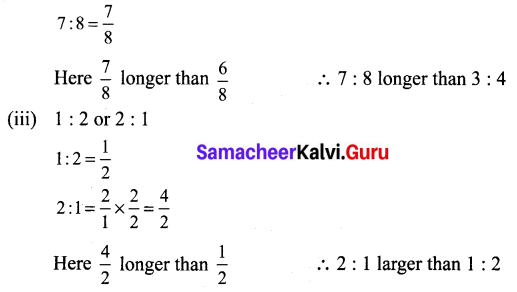You can Download Samacheer Kalvi 6th Maths Book Solutions Guide Pdf, Tamilnadu State Board help you to revise the complete Syllabus and score more marks in your examinations.
Tamilnadu Samacheer Kalvi 6th Maths Solutions Term 1 Chapter 3 Ratio and Proportion Ex 3.2
![]()
Question 1.
Fill in the blanks of the given equivalent ratios.
(i) 3 : 5 = 9 : ___
(ii) 4 : 5 = ___ : 10
(iii) 6 : ____ = 1 : 2
Solution:
(i) 3 : 5 = 9 : ……
\(\frac{3}{5}\) = \(\frac{9}{x}\)
3 × x = 9 × 5
x = \(\frac{9×5}{3}\)
x = 15
3 : 5 = 9 : 15
(ii) 4 : 5 = …… : 10
\(\frac{4}{5}\) = \(\frac{x}{10}\)
5 × x = 4 × 10
x = \(\frac{4×10}{5}\)
x = 8
4 : 5 = 8 : 10
(iii) 6 : …… = 1 : 2
6 : x = 1 : 2
\(\frac{6}{x}\) = \(\frac{1}{2}\)
1 × x = 6 × 2
x = 12
6 : 12 = 1 : 2
Question 2.
Complete the Table:

Solution:

Question 3.
Say True or False.
(i) 5 : 7 is equivalent to 21 : 15.
(ii) If 40 is divided in the ratio 3 : 2, then the larger part is 24.
Solution:
(i) False
Hint: \(\frac{21}{15}=\frac{7}{5}=7: 5\)
(ii) True
Hint: \(\frac{3}{5} \times 40=24\)
Question 4.
Give two equivalent ratios for each of the following.
(i) 3 : 2
(ii) 1 : 6
(iii) 5 : 4
Solution:

![]()
Question 5.
Which of the two ratios is larger?
(i) 4 : 5 or 8 : 15
(ii) 3 : 4 or 7 : 8
(iii) 1 : 2 or 2 : 1
Solution:


Question 6.
Divide the numbers given below in the required ratio.
(i) 20 in the ratio 3 : 2
(ii) 27 in the ratio 4 : 5
(iii) 40 in the ratio 6 : 14
Solution:
(i) 20 in the ratio 3 : 2.
Dividing 20 into 3 + 2 = 5 equal parts, then
\(20 \times \frac{3}{5}=12\) , \(20 \times \frac{2}{5}=8\)
The required answer is 12, 8
(ii) 27 in the ratio 4 : 5.
Dividing 27 into 4 + 5 = 9 equal parts, and
\(27 \times \frac{4}{9}=12\) , \(27 \times \frac{5}{9}=15\)
The numbers are 12, 15
(iii) 40 in the ratio 6 : 14.
Dividing 40 into 6 + 14 = 20 equal parts and
\(40 \times \frac{6}{20}=12\) , \(40 \times \frac{14}{20}=28\)
The numbers are 12, 28.
Question 7.
In a family, the amount spent in a month for buying Provisions and Vegetables is in the ratio 3 : 2. If the allotted amount is ₹ 4000, then what will be the amount spent for
(i) Provisions and
(ii) Vegetables?
Solution:
Dividing the total amount ₹ 4000 into 3 + 2 = 5 equal parts then
(i) For Provisions:
3 out of 5 parts are spent for provisions and 2 out of 5 parts for vegetables.
\(4000 \times \frac{3}{5}=2400\) for provisions
(ii) For vegetables:
\(4000 \times \frac{2}{5}=1600\) for Vegetables.
₹ 2400 spend on provisions and ₹ 1600 spend on Vegetables.
![]()
Question 8.
A line segment 63 cm long is to be divided into two parts in the ratio 3 : 4. Find the length of each part.
Solution:
Total length 63 cm, on dividing 3 + 4 = 7 equal parts,
we get the line segments with lengths
\(\frac{3}{7} \times 63=27 \mathrm{cm}\) , \(\frac{4}{7} \times 63=36 \mathrm{cm}\)
Length of each line segment is 27 cm and 36 cm
Objective Type Questions
Question 9.
If 2 : 3 and 4 : ___ or equivalent ratios, then the missing term is ____
(a) 6
(b) 2
(c) 4
(d) 3
Solution:
(a) 6
Hint: \(\frac{2}{3}=\frac{2 \times 2}{3 \times 2}=\frac{4}{6}\)
Question 10.
An equivalent ratio of 4 : 7 is
(a) 1 : 3
(b) 8 : 15
(c) 14 : 8
(d) 12 : 21
Solution:
(d) 12 : 21
Hint: \(\frac{12}{21}=\frac{3 \times 4}{3 \times 7}=\frac{4}{7}\)
Question 11.
Which is not an equivalent ratio of \(\frac{16}{24}\) ?
(a) \(\frac{6}{9}\)
(b) \(\frac{12}{18}\)
(c) \(\frac{10}{15}\)
(d) \(\frac{20}{28}\)
Solution:
(d) \(\frac{20}{28}\)
Hint: \(\frac{16}{24}=\frac{8 \times 2}{8 \times 3}=\frac{2}{3}\)
Question 12.
If ₹ 1600 is divided among A and B in the ratio 3 : 5, then, B’s share is
(a) ₹ 480
(b) ₹ 800
(c) ₹ 1000
(d) ₹ 200
Solution:
(c) ₹ 1000
Hint: B’s share = \(\frac{5}{8} \times 1600=1000\)
![]()